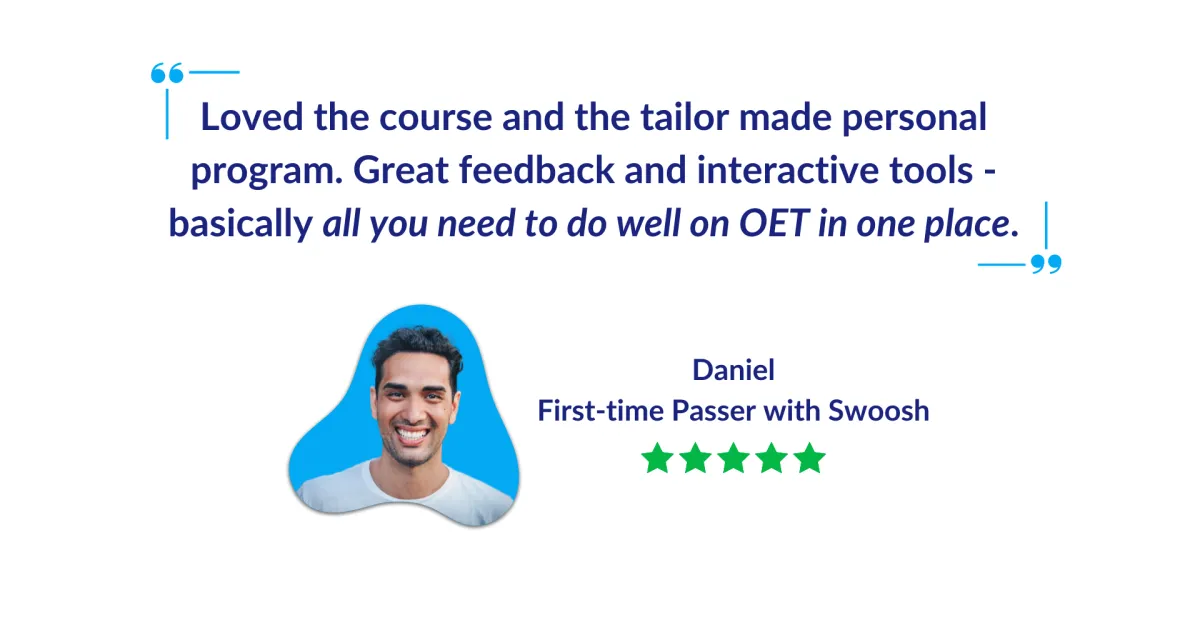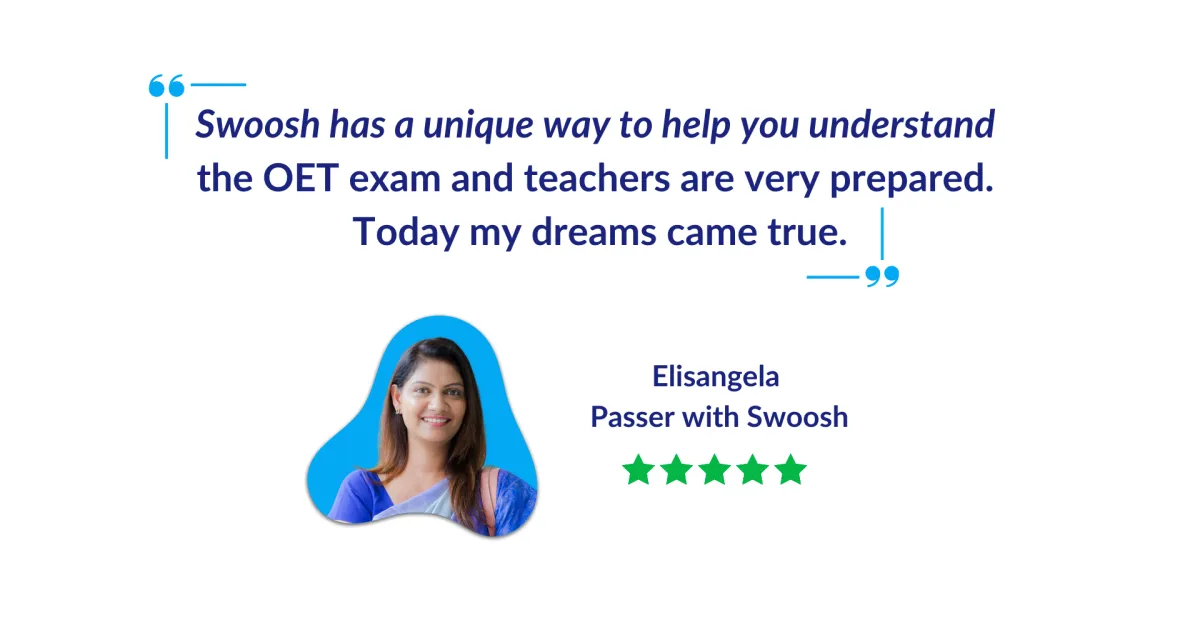Want to pass your OET exam faster?
OET Podcast Series
How to pass your OET exam with confidence.
Scroll down to watch to the entire series for FREE along with access to each episodes notes and top tips. Or, choose to listen on your favourite podcast platform from the options below.
Welcome to our OET podcast hosted by OET experts,
Scott and Una.
In this podcast series we will show you how to successfully plan your exam preparation and give you tips and strategies to pass OET on your first or next attempt.
To listen, select from the list below and simply press play. Enjoy!
LOWEST PRICE
6 Months Access
Starter
$49
Or 3 Payments of $16.33 with

Here's everything you get:
OET Exam Readiness Test
Assess your English and learn your current level for the exam to see when you will be ready to pass.
4 Self-study Video Courses on all subtests
Get in-depth self-study video courses that cover reading, listening, speaking, and writing. Gain a detailed understanding of the exam format and how to complete each task.
60 Hours of OET Live Class Recordings
Missed a class? You have access to 80 hours of live class recordings to watch back so you won’t miss out.
5 Sets of Reading and Listening Mock Exams
Practice with mock exams designed by experts to replicate the real OET exam. Then watch post mock-exam analysis videos for a breakdown of the answers.
5 Sets of Speaking Role-play Cards and 5 Sets of Writing Case Notes
Practice your writing and speaking skills with mock examples to ensure you are feeling confident for exam day.
Letter Model Answer Bank
Study grade A OET letters written by expert teachers to learn how you should write your letters to get high scores.
10 Previously Corrected Letters
Learn from the mistakes of other students with this bank of previously corrected letters
GREAT VALUE
9 Months Access
Accelerator
$99
Or 3 Payments of $33 with

Here's everything you get:
OET Exam Readiness Test
Assess your English and learn your current level for the exam to see when you will be ready to pass.
4 Self-study Video Courses on all subtests
Get in-depth self-study video courses that cover reading, listening, speaking, and writing. Gain a detailed understanding of the exam format and how to complete each task.
2 Writing Corrections
Submit OET letters to expert teachers and receive detailed feedback according to the task criteria. Learn your mistakes and where you need to improve.
7 days a week Writing Corrections Service
Our expert teachers will correct your letters every day of the week and send your detailed feedback within 24 hours of submission.
Unlimited Live Group Classes on all Skills
Join live classes on reading, listening, speaking and writing at a time zone that suits you with 10 classes available per week.
Writing Correction Classes
Join 3 OET letter correction classes per week where an expert teacher will discuss real letter examples and provide writing feedback
60 Hours of OET Live Class Recordings
Missed a live class? Watch the recording to catch up at a time that suits you.
6 Sets of Reading and Listening Mock Exams
Practice with mock exams designed by experts to replicate the real OET exam. Then watch post mock-exam analysis videos for a breakdown of the answers.
6 Sets of Speaking Role-play Cards and 6 Sets of Writing Case Notes
Practice your writing and speaking skills with mock examples to ensure you are feeling confident for exam day.
Letter Model Answer Bank
Study grade A OET letters written by expert teachers to learn how you should write your letters to get high scores.
15 Previously Corrected Letters
Learn from the mistakes of other students with this bank of previously corrected letters
Episode 1
How to pass OET Speaking and Writing
In our debut episode of the Swoosh English podcast, you will learn key exam preparation techniques to set you up for OET study success for the Speaking and Writing elements of your OET test. Listen to our experienced OET teachers, Scott and Una, introduce you to the fundamentals of learning the English language and also equip you with tips on how to prepare and improve your Speaking and Writing skills for this part of your OET exam.
This podcast episode will provide exam pointers on how you can improve your overall language ability as a part of your OET exam preparation.
Our top tips include:
- Communicating for a purpose
- Practising your speaking
- Using writing correction tools
- Receiving feedback on your speaking
- Reviewing the fundamentals
As your OET exam date comes closer, these tips will help you plan your revision time effectively.
Do you want to dive deeper into the strategies needed to pass your OET exam with expert teachers?
Take your skills to the next level with our FREE OET Masterclass and learn proven exam tips and strategies from our experienced teachers!
Register for our FREE OET Masterclass here and take the next step towards achieving your career goals! Spots are limited so don't miss out!
Key times for our top tips:
03:24 - Tip #1: Communicating for a purpose
Find the motivation and focus to write and practise and keep practising! Write letters, interact in forums, comment on social media, fill out forms, and send emails to keep practising your English writing skills. Practice makes perfect!
11:52 - Tip #2: Practising your speaking
We recommend you seek out communities to intentionally practise your English. Some online community options include Meetup, InterPals, and Skype. These are free chat spaces where you can meet fellow students who are also trying to improve their English. The use of such communities will support you to become stronger in your day to day use of the English language.
14:20 - Tip #3: Using writing correction tools
Spell-checker and grammar correctors like Grammarly are very useful and will tell you typographical, spelling, punctuation and even sentence formulation errors.
16:34 - Tip #4: Receiving feedback on your English speaking
Comments from a native English speaking teacher provide invaluable feedback. Always try and get your feedback from a qualified English teacher, as this helps in understanding where and how you are making mistakes and how to fix them.
18:18 - Tip #5: Reviewing the fundamentals
Don’t forget to keep reviewing the fundamentals. These include basic building blocks like the organisation of your writing, grammatical devices, cohesive devices, spelling, linking of speech, intonation, word and sentence stresses, overall fluency, and pronunciation.
Episode 2
How to write a successful referral letter for Nurses and Doctors
In episode 2 of our OET podcast series, we teach you how to write the perfect OET referral letter. OET referral letter writing is a subject that most professionals struggle with, however, after you finish this episode you will be much more confident in successfully writing one independently. Since the OET referral letter writing process for nurses and doctors is different, you need to learn how to make it clear in terms of the English language and healthcare professional input. Sticking to your word limit during your OET test is important and is covered in this episode.
Getting the right amount of OET 2.0 referral letter writing samples for nurses and doctors is crucial in studying effectively. In this podcast, we explain the OET referral letter scoring styles to follow while writing the letter. If you are in a rush and your OET exam date is close, you can take our OET Intensive course and learn to prepare in an accelerated way. The OET exam can easily be passed with the right exam preparation.
Do you want to dive deeper into the strategies needed to pass your OET exam with expert teachers?
Take your skills to the next level with our FREE OET Masterclass and learn proven exam tips and strategies from our experienced teachers!
Register for our FREE OET Masterclass here and take the next step towards achieving your career goals! Spots are limited so don't miss out!
Key times for our top tips:
01:43 - Overview of the OET Writing Task
Part of the OET Writing task includes creating a profession-specific letter. If you are a doctor you will be writing as a doctor and if you are a nurse you are writing as a nurse. Non-doctors and nurses will also get a chance to write for their own relevant professions.
05:12 - OET Writing task scoring and criteria
1, Conciseness and clarity – Scored on a scale of 0 to 7
2, Genre and style – Scored on a scale of 0 to 7
3, Be polite in your tone but not over the top, as it affects your word count.
4, Organisation and layout – Scored on a scale of 0 to 7
5, Organised well and easy to read.
6, Language – Scored on a scale of 0 to 7
11:53 - Referral letter writing process
1, Introduction to the letter-writing process
2, What’s the purpose of the letter
3, Main health issue
4, Request - The referral letter should request the recipient to care for the patient after all the medical information is conveyed.
17:20 - Sample introduction for an OET referral letter
Include the most recent information. Summary of the previous case, social and medical history. Focus on the outcome and what you want the reader to do. Use dates and linking words and phrases to make your letter cohesive overall
21:25 - Tips: Avoid common language mistakes
Make sure you are working on your usual mistakes in vocabulary and spelling. A lot of students make the same mistakes like using the wrong tenses and articles while writing their letters. These mistakes in spelling and vocabulary can be avoided if noticed early.
Episode 3
What are OET Writing Assessment criteria?
In this third episode of our podcast, expert UK English speakers Scott and Una explain what OET writing assessment criteria are. This is very important to understand if you are attempting your OET writing test. In the previous podcast we introduced you to OET referral letter writing tips. In this podcast we will explain it further and take you through how to write better keeping in mind the writing assessment descriptors.
There are 6 concrete OET writing criteria that you have to understand before attempting the OET exam and trying to score an A or a B:
1, Purpose
2, Content
3, Conciseness and clarity
4, Genre and style
5, Organisation and layout
6, Language
Once you have clarity on these basic criteria you will be in a better position to pass the OET exam. If you are looking to score B or A in OET writing, this podcast can absolutely help you. You can also find out more OET writing tips from our free complete writing guide. We are really looking forward to you passing your OET exam with A or B scores.
Do you want to dive deeper into the strategies needed to pass your OET exam with expert teachers?
Take your skills to the next level with our FREE OET Masterclass and learn proven exam tips and strategies from our experienced teachers!
Register for our FREE OET Masterclass here and take the next step towards achieving your career goals! Spots are limited so don't miss out!
Key times for our top tips:
01:22 - The 6 OET Writing Criteria:
01:51- Purpose – scored on a scale of 0 to 3
The purpose is typically referring someone to another professional.
03:10 Content – scored on a scale of 0 to 7
Ask yourself; have I included all the necessary information accurately?
08:59 - Conciseness and clarity – Scored on a scale of 0 to 7
If you are going above 220 words, your conciseness is not yet fully up to scratch.Clarity refers to communicating the information clearly.
12:31 - Genre and style – scored on a scale of 0 to 7
Assesses how appropriate your language is. Being able to write in a short, factual and clinical style.
16:30 - Organisation and layout – scored on a scale of 0 to 7
The first subsection should state your purpose. The following subsections will depend on the case notes, so you should think carefully about how to organise the information logically for your reader.
19:43 - Language – scored on a scale of 0 to 7
Your ability to use a range of appropriate language features accurately is scored in this section.
23:30 - Final point: as you are writing your letters, get a teacher to double-check the errors you are making and self-reflect on the mistakes you make.
Episode 4
How to use the case notes effectively in OET Writing
In our fourth episode of the OET podcast series, our UK teachers Scott and Una explain how to use case notes effectively to make your OET writing task more manageable. There are a lot of instances where students just copy and paste the details in the case notes into the letters instead of making them into grammatically correct sentences. In this episode, you can learn how to make your OET referral letter cohesive with the right use of details from the case notes. We also talk you through how to manage your time better while doing your writing task. Learning how to analyse the OET case notes helps in writing the referral letter quicker and getting an A or B on your OET test.
Do you want to dive deeper into the strategies needed to pass your OET exam with expert teachers?
Take your skills to the next level with our FREE OET Masterclass and learn proven exam tips and strategies from our experienced teachers!
Register for our FREE OET Masterclass here and take the next step towards achieving your career goals! Spots are limited so don't miss out!
Key times for our top tips:
01:43 - Overview of OET Writing
The task involves writing a letter, more often than not a referral letter, that is profession-specific. You get 45 minutes in total, in which you will have the first 5 minutes to plan and then 40 minutes to write. Use the 5 minutes in the beginning wisely! The letter should be written clinically and factually.
07:31 - Scoring criteria for OET Writing
State the purpose in the first paragraph. Include accurate information in the letter. Take into consideration how much relevant and irrelevant information is included. Look at the word count (is your letter between 180 and 200 words?).
09:59 - First thing to do:
Establish the purpose of the letter. Who are you writing to? Are they in the same profession as you? Recipient and patient’s name? Main ailments? And what action do you want the reader to take?
12:11 - Analysing the case notes
Skim the notes in the first 5 minutes to catch the information that is jumping out at you. The case notes are written in bullet points. Keep the recipient in your mind the whole time to make sure you convey the right information. Highlight or circle relevant information.
19:18 - Expanding the case notes in your letter
Use articles (a, an and the). Use pronouns.
OET Case note examples:
“6-week history progressively ↑ p in R and L knee joints”
Answer with articles:
The patient has a 6-week history of progressively increasing pain in the right and left knee joints.
Episode 5
How articles and connectors are used in OET Writing
In the 5th episode of our OET podcast series Scott and Una talk about the use of articles and connectors in the OET writing task. They discuss their experience of students struggling to find the right use of connectors and articles. This podcast explains how you can effectively use articles and connectors while transferring details from the case notes to your OET writing task. We also explain when and where to use them and how to write an OET letter in limited time. You can learn more about this in our free writing guide.
Do you want to dive deeper into the strategies needed to pass your OET exam with expert teachers?
Take your skills to the next level with our FREE OET Masterclass and learn proven exam tips and strategies from our experienced teachers!
Register for our FREE OET Masterclass here and take the next step towards achieving your career goals! Spots are limited so don't miss out!
Key times for our top tips:
Tip 1 - Add articles to the case notes!
Always use articles with nouns. Check if it is a singular or a plural noun. “A” and “an” can only be used with countable nouns. “The” can be used with countable and uncountable nouns.
Is the content general or specific? If specific, “the” should be used, while “a” and “an” refer to something general. If you are mentioning something for the first or the second time, use “a” and “an” and for the second time, use “the”. There should be more “a” and “an” towards the beginning of the letter.
Tip 2 - Connectors in OET writing
A device that connects two clauses. There are simple connectors and complex connectors. Connectors offer additional information (emphasise contrasting or similar meanings, show cause and effect, add reason and show succession). Make sure you avoid academic connectors like “besides”, “furthermore”, “hence” and “aforementioned”. Be careful not to overuse connectors!
Tip 3 - Create a sample letter under timed conditions like in the OET where you only have 45 minutes. This technique of practising will set you up well on the day of the OET examination.
Want access to live classes and personalised support from the experts?
Get 10% off OET courses as our treat to you, our podcast listener.
Use coupon code: SWOOSH10
Episode 6
How to use tenses in OET Writing
In the 6th episode of our OET podcast series, we go deeper into OET writing and discuss the correct use of tenses. Our expert teachers, Scott and Una, talk from their past experiences about how many students find it difficult to get this aspect of writing correct. Your background in English learning can cause a problem in understanding tenses, however with resources like this OET podcast and our other courses, you can easily overcome this barrier.
We talk in detail about 4 tenses in the English language:
1, Present simple
2, Past simple
3, Present perfect
4, Present continuous
Do you want to dive deeper into the strategies needed to pass your OET exam with expert teachers?
Take your skills to the next level with our FREE OET Masterclass and learn proven exam tips and strategies from our experienced teachers!
Register for our FREE OET Masterclass here and take the next step towards achieving your career goals! Spots are limited so don't miss out!
Key times for our top tips:
Tenses are important for the language assessment criterion. Incorrect tenses might confuse your readers in the real world.
Present Simple Tense
The present simple tense is used to report unchanging facts like a person’s name, age, and job with verbs like do, make, and come. Example: “The patient is allergic to penicillin.”
Past Simple Tense
To use the past simple tense, change the verbs from do, make and come to did, made and came. This tense provides information about a time that the patient visited you in the past and is told in the context of a fixed period: two weeks ago, last month, and yesterday. For example:“The patient first presented 2 months ago with a bowel complaint. At this time, she displayed symptoms consistent with IBS.”
Present Perfect Tense
This tense is used to state an action or an event which may have occurred in the past but remains relevant at this time. There is no set period. For example:“I have prescribed the patient Propranolol to help control his anxiety.”“The patient has received massage therapy for the last 5 months.”Indicator words like “for” and “since” are used while using the present perfect.
Present Continuous Tense
This tense is designed to show an action which is specifically relevant to the present and can be used to refer to something very recent. Examples:“The patient’s condition is deteriorating.”“The patient is refusing to take her medication.”
Final point: Get feedback and improve your knowledge of tenses by making a table that lists articles, tenses, and pronouns and go through your letters correcting your mistakes.
Episode 7
How to achieve a high score in the OET Speaking Test
In episode 7 of our OET podcast series Scott and Una discuss how to score highly in the OET Speaking Test. OET Speaking can be scary for many students as it requires you to speak to another person in comprehensive English. We look at how you can feel more prepared for the OET Speaking Test by understanding the fundamentals of role-playing. We also discuss some amazing preparation methods which can help you in achieving a higher score. The OET Speaking task can look overwhelming but, with the input from our teachers, you can relax and understand how to tackle this OET task without getting worried. You can also check out our OET courses where you can get feedback on your speaking skills and vocabulary.
Do you want to dive deeper into the strategies needed to pass your OET exam with expert teachers?
Take your skills to the next level with our FREE OET Masterclass and learn proven exam tips and strategies from our experienced teachers!
Register for our FREE OET Masterclass here and take the next step towards achieving your career goals! Spots are limited so don't miss out!
Key times for our top tips:
01:42 - OET Speaking Overview
This section lasts for 20 minutes in total and you need to complete 2 role-plays. You have 3 minutes to plan for each role-play and 5 minutes to execute.Before the role-plays begin, there is a brief, un-assessed section for 2 minutes where the examiner will ask you questions about your profession. The role-plays are designed to replicate real-life medical situations where you are trying to comfort a patient regarding their medical issues.
05:00 - Criteria for assessing your OET Speaking skills
You are assessed on 9 different criteria for communication and linguistic skills:
Communication:
1, Relationship-building
2, Understanding and incorporating the patient’s perspective
3, Providing structure
4, Information gathering
5, Information givingLinguistic:
6, Intelligibility
7, Fluency
8, Appropriateness of language
9, Resources of grammar and expression
10:58 - Role play structure and method
Speak at a natural pace without false starts. Use the 3 minute preparation time to take out the essential information like patient profiles and how they are feeling. Also, think of how you will express yourself. Take notes and be sure to ask open-ended questions. Give a good opening to make the patient feel comfortable. Use sequencing phrases like “firstly”, “after that”, “and then” and “next”.For a final impression, you can repeat the points that you made in a natural way and say goodbye to the patient.
21:08 - Final tips: work on the feedback that you have been given, have a vocabulary list and record yourself.
Episode 8
How to show empathy in OET Speaking
In episode 8, UK language teachers, Scott and Una, discuss the importance of displaying empathy in your OET speaking task. They start off by defining empathy for the OET podcast listeners. This is an essential skill to master as the OET speaking task constantly measures how comfortable the patient is with you and how well you can calm their anxieties. Besides vocabulary, we also outline the importance of body language and tone of voice when preparing for your OET speaking task. Check out our courses to get expert training and pass your OET exam the first time.
Do you want to dive deeper into the strategies needed to pass your OET exam with expert teachers?
Take your skills to the next level with our FREE OET Masterclass and learn proven exam tips and strategies from our experienced teachers!
Register for our FREE OET Masterclass here and take the next step towards achieving your career goals! Spots are limited so don't miss out!
Key times for our top tips:
02:40 - What is empathy?
It is the ability to understand how someone else feels because you can imagine what it is like to be them.
03:57 - Overview and criteria of OET Speaking
The OET Speaking task is 20 minutes in total with 2 role-plays. For each role-play, you are given a 2-minute warm-up conversation with the interlocutor, 3 minutes to study the role play card and analyse the situation you are dealing with and 5 minutes for the role-play itself.
05:45 - Clinical communication criteria
- Relationship-building: demonstrating empathy and respect.
- Understanding and incorporating the patient’s perspective.
- Providing structure.
- Information gathering.
- Information giving.
09:49 - How to show empathy
1, Show that you are putting your patient at ease because they are nervous and anxious. Start with a friendly greeting.
Examples:
“Hello, how are you feeling today?”
“Good morning, my name is nurse [your name], and I will be your charge nurse today.”
Acknowledge the discomfort immediately:
“I can imagine that you are anxious about your visit today, but I assure you that I am here to support you and assist in your recovery.”
2, Backchanneling
Use words and body language to indicate that you are listening because having no reaction sends the message that you do not care.
Examples:
- Nod your head
- Say “Of course, of course”.
3, Putting yourself in the patient’s shoes
Direct empathy: You are able to empathise because you have experienced it yourself.Example: “I understand your concerns about choosing whether to opt for pain relief during labour. I faced the same decision myself before I was due to give birth.”
Indirect empathy: You have not been in that situation before but you still use language that shows you can empathise with the situation.
Example:
“I can’t begin to imagine how you’re feeling when receiving this news. Please know that we did everything we possibly could to save your family member.”
4, Use of intonation to show appropriate empathy
You can express empathy by lowering your intonation (falling intonation) versus using a flat or rising tone. Tone plays an important role in making the patient comfortable, make sure you receive feedback on this and work on it.
Episode 9
How the examiner marks your OET Speaking skills
In this 9th episode of the OET podcast, Una finds out about Scott's experience as an interlocutor for an OET Speaking task. Most students rely on OET speaking samples to learn how to prepare for OET speaking tests, however, you can listen as Scott shares his experience when he actually supervised an OET Speaking task while working in Australia. This is a very informative episode as Scott talks you through the various qualities they look for in a candidate. We also talk in-depth about some pointers that help make your OET Speaking task preparation much easier. Choose one of our online OET courses to receive more of such tips from experienced OET teachers such as Scott and Una.
Do you want to dive deeper into the strategies needed to pass your OET exam with expert teachers?
Take your skills to the next level with our FREE OET Masterclass and learn proven exam tips and strategies from our experienced teachers!
Register for our FREE OET Masterclass here and take the next step towards achieving your career goals! Spots are limited so don't miss out!
Key times for our top tips:
01:55 - What is the role of an OET interlocutor?
The interlocutor takes the part of the patient on the day of the examination. They have no say in assessing your performance during the role play.
03:50 - What does an OET Interlocutor do on exam day?
Scott handled 15 students maximum in a day. He prepared the case notes, recorder, written notes and list of scheduled candidates before going through the interlocutor process.
05:22 - The biggest challenge for an interlocutor
Putting a student at ease and showing them that the interlocutor is there to help them get the best marks can be challenging at times. There was one instance of a student that was so nervous on the day that they really struggled to give their response and their score may have been negatively affected.
07:50 - How can you best serve the candidate on the day of the test?
You do not want to add pressure to the student so it is best to smile, be patient and professional and give them useful information to replicate a real role play.
09:00 - OET Speaking tips for candidates
To prepare for the Speaking Test, do some practice role-plays, including mock speaking practice with a qualified OET teacher or study buddy. Also, be sure to get feedback and address the criteria as much as possible.
And do not forget to be relaxed! Do not rush through it.
Episode 10
How to get a high score in OET Reading and Listening
In episode 10, Scott and Una discuss the OET Reading and Listening tests and how to score an A or B. We also discuss how important it is for the student to have both his/her OET language and test-taking skills up to par to score well in these sections. In addition to this, using medical journals and other publications to enhance your knowledge of medical vocabulary is a conversation topic in this podcast. For the OET Listening Test, using techniques such as listening to authorised podcasts is another top tip to help you in your OET exam preparation journey. To learn more about how to score good marks in OET Listening and Reading enrol in one of our online OET test preparation courses.
Do you want to dive deeper into the strategies needed to pass your OET exam with expert teachers?
Take your skills to the next level with our FREE OET Masterclass and learn proven exam tips and strategies from our experienced teachers!
Register for our FREE OET Masterclass here and take the next step towards achieving your career goals! Spots are limited so don't miss out!
Key times for our top tips:
03:32 - OET Reading tip: Read medical journals
Check for new English words and notice sentence structure, linking words and phrases, conjunctions and transition words. Write down new words with their definitions, word families, synonyms, and pronunciation notes. Try to read a journal and figure out the meaning of unfamiliar words within context.Medical journal example: British Medical Journal
06:25 - OET Listening tip: Listen to medical podcasts
Be sure to listen to podcasts with different accents and take down notes. Medical podcast examples: ABC’s All in the Mind and BBC’s HealthCheck UK Live
Read newspapers and websites
Look up topics that interest you to make your reading fun and informative.
Listen to YouTube videos
You can find interesting videos in English on almost any topic that interests you.
Try listening instead of watching to avoid distractions, then watch again with video and then again with subtitles.
15:20 - Access graded content
You can find graded content that is suitable to your level at the Common European Framework of Reference for Languages (CEFR).
Episode 11
How to get a high score in OET Reading Part A
In the 11th episode, Scott and Una share their expertise on how to score a minimum grade of B in the OET Reading Part A section of the OET test. We look at what is expected from a student in this part of the exam and how you can be prepared for it. We discuss the time limit for the Reading test and how you can break down each section to finish it on time. Other great insights include helpful tips like scanning passages for keywords to find answers more quickly. To learn more and prepare properly to score at least a B in OET Reading, enrol in one of our OET online classes.
Do you want to dive deeper into the strategies needed to pass your OET exam with expert teachers?
Take your skills to the next level with our FREE OET Masterclass and learn proven exam tips and strategies from our experienced teachers!
Register for our FREE OET Masterclass here and take the next step towards achieving your career goals! Spots are limited so don't miss out!
Key times for our top tips:
03:56 - Overview of OET Reading Part A
This section is known as Expeditious Reading. It has 4 texts and there are 3 different exercises: gap fill, matching and short answer style questions. You will answer 20 questions and are given 15 minutes to complete them. Part A requires you to use skimming and scanning skills so please take note that the time limit is strict.
This part will feature questions about treatment options, daily care, and advice given to patients. There will not be case studies, articles or journals. The first part of the test is always matching questions and has approximately 7 question items. The rest of the questions will either be short answers or gap fill questions.
07:36 - OET Reading Part A scoring
You are likely looking for a B score in every section for immigration purposes. OET describes the B criteria as a high level of performance with fluency and accuracy and is adequate for your professional needs. This equates to 7 to 7.5 in IELTS. Spelling is really important in Part A and misspelt words mean you get no marks for that item.
10:57 - The recommended method
For questions 1 to 7, start by skimming the text or looking for the gist, get a good idea of the topic of each text and then match the questions to the text. Be sure to check the headings and subheadings for clues regarding the content of the text. Questions 8 to 20 involve scanning, which means going through the text to find particular information using keywords. If you are struggling with a question, simply move on to the next.
18:34 - Some extra tips
- Do mock exams to be familiar with the kind of texts that will appear in this section.
- Read newspaper articles, medical journals and articles that interest you.
- Have a vocabulary journal and write down new words and meanings.
- Take an OET readiness test.
Want access to live classes and personalised support from the experts?
Get 10% off OET courses as our treat to you, our podcast listener.
Use coupon code: SWOOSH10
Episode 12
How to get a high score in OET Reading Part B
In episode 12 of the OET podcast series, UK OET teachers, Scott and Una, discuss the OET Reading Test, particularly Part B. This section of the OET exam tests your ability to quickly understand documentation and in this episode, we discuss the format of the exam questions and allocated time per section. You will hear some tips about how you can identify paraphrasing to avoid wasting time and follow pointers on best practices which help to score an A or B in this OET test section. To learn more about the OET Reading exam, enrol in one of our online OET classes.
Do you want to dive deeper into the strategies needed to pass your OET exam with expert teachers?
Take your skills to the next level with our FREE OET Masterclass and learn proven exam tips and strategies from our experienced teachers!
Register for our FREE OET Masterclass here and take the next step towards achieving your career goals! Spots are limited so don't miss out!
Key times for our top tips:
04:00 - Overview of OET Reading Part B
This section has 6 short texts, each between 100 and 150 words. There are 6 questions with 3 multiple choice answers for each question. These texts are general and will typically be policy documents, workplace updates, hospital notices, instruction manuals or hospital procedures. The questions will ask about specific details or the general meaning.
06:42 - Scoring and how to approach this task
There are only 6 questions in this section and you have about 2 minutes on average to answer each question. To score a B, you need to answer 4 questions correctly. To start, first look at the text and decide what the overall topic is. Then, read in detail immediately because the answers are likely to be paraphrased in some way. For this task, comprehension is key.
13:05 - Recognising paraphrasing and other distractors
Sentences in the text can be reworded and reformulated by adding words that completely change their meaning. For example, different modal verbs where the statement uses "must" while the answer uses "should" or different quantifiers like "some" or "all" or "none".
15:00 - Questions that relate to specific details and gist
A detailed question example is:
"The manual informs us that the blood pressure monitor…"
Answer example:
"May not work correctly in close proximity to other devices.”
You need to find information that contradicts the other answers to prove that they are not correct.
17:59 - Final tips
It is fine if you do not know every word in the text! So keep practising your ability to recognise paraphrasing by reading in your own time. You can compile a vocabulary journal to make sure you recognise more words and increase your understanding of the English language.
Take an OET exam readiness test. You can also take a mock test to experience the strict time constraints of the OET.
Episode 13
How to get a high score in OET Reading Part C
In this episode of the Swoosh English OET podcast, English teachers Scott and Una discuss Part C of the OET Reading exam. This is comparatively a difficult part of the OET test for many students because unlike other sections the passages here are long and are usually excerpts from medical journals or publications. You need to be careful with this section as it can potentially lead you to spend too much time on one question. In this podcast, we advise you on how to solve this OET problem. You need to understand the lexical references and attitude of the author before you proceed and we talk you through this. Learn more OET exam tips from our online OET courses whilst also receiving expert advice and lessons.
Do you want to dive deeper into the strategies needed to pass your OET exam with expert teachers?
Take your skills to the next level with our FREE OET Masterclass and learn proven exam tips and strategies from our experienced teachers!
Register for our FREE OET Masterclass here and take the next step towards achieving your career goals! Spots are limited so don't miss out!
Key times for our top tips:
04:00 - Overview of OET Reading Part C
Part C features 2 long texts which are between 700 and 850 words each. There are 16 questions, 8 for each text, of which there are 4 multiple choice answers. There are 3 different question types. The texts are academic journals and texts which are not specialised and aimed at a general medical audience.
06:53 - Scoring and how to approach this task
For Part C, you need to find the gist or overall meaning of the text, as well as understand the attitude of the writer. There are 2 questions on lexical references and 6 questions about other details like opinions and attitudes of the writer or people within the text.
First, you need to skim the text, especially the first sentences of the paragraphs. This gives you the context of the questions and also lets you pick up on the writer's opinions and attitudes. Then, you need to look at the questions and read carefully because paraphrasing will occur. Be sure to look out for adjectives (which are often used to express opinions), as well as modal verbs like "should", "might" and "probably".
17:49 - Recognising referencing & phrases to detect meaning from
Look at the part of speech: is it a noun or adjective? Is it a subject? Is it an object? Be sure to ask yourself about its connotation and if it is expressing a negative, positive or neutral idea. Also, look at connectors and transition words.
23:42 - Additional resources & tips
Read medical journals, websites and newspaper articles like the British Medical Journal and the ABC health newsletter. TED Talks are another helpful resource. You can Google unfamiliar words to hear their proper pronunciation. It is also advisable to have a vocabulary journal and write down the meanings of words and other notes.
Episode 14
How to skim read in your OET Reading Test
In this 14th episode of the OET podcast series by Swoosh English UK language teachers, Scott and Una, are back with us to talk about the benefits of learning how to apply the skimming technique in your OET Reading Test. OET Reading is a timed part of the test that is split into three sections; A, B and C. All these tasks need to be completed in time and many students struggle with finishing them on time even after multiple attempts. In this podcast, you can learn how to solve this issue by successfully skimming through the OET reading questions. We also discuss the key parts of the passages that you can skim to get the most out of the text.
Do you want to dive deeper into the strategies needed to pass your OET exam with expert teachers?
Take your skills to the next level with our FREE OET Masterclass and learn proven exam tips and strategies from our experienced teachers!
Register for our FREE OET Masterclass here and take the next step towards achieving your career goals! Spots are limited so don't miss out!
Key times for our top tips:
02:07 - What is skimming?
It is defined as reading expeditiously and quickly through a text while looking for the overall idea, which is also known as the gist. Skimming gives you the context of the text.
03:25 - How to skim in the OET Reading Test
- Look at the headings. You can get a lot of information on what to expect to read in the body of the text.
- Example: Seeing the word "arm fractures" references joints, fractures, and different positions in the way aback slab should be placed.
- Check the layout of the text (tables, paragraphs, graphs, bullet points and case notes)
09:38 - Topic sentence
- Gives a general or overall meaning of a given topic for a paragraph or text.
- Topic sentences give an idea of what kind of opinion the text contains.
Episode 15
How to use scanning to score highly in OET Reading
In this 15th episode of the OET podcast UK English language teachers, Scott and Una, talk about how to scan through your OET reading questions and paragraphs to finish the OET test on time. The time constraint on the OET test is a big issue for many first time OET students. With this podcast, we aim to provide a solution to that issue by introducing you to a technique called scanning. We discuss how scanning is different from skimming, which was discussed in the last episode. You can listen to all our episodes here. Scanning allows you to eliminate irrelevant information while locating a specific point within the text. We also talk about paraphrasing and how it can be beneficial to scoring well on your OET Reading Test.
Do you want to dive deeper into the strategies needed to pass your OET exam with expert teachers?
Take your skills to the next level with our FREE OET Masterclass and learn proven exam tips and strategies from our experienced teachers!
Register for our FREE OET Masterclass here and take the next step towards achieving your career goals! Spots are limited so don't miss out!
Key times for our top tips:
01:40 - Recap: Skimming vs Scanning
- Skimming: Quickly reading through the text to get a good understanding of the gist of the text.
- Scanning: Passing your eyes rapidly over the text while searching for specific information while also eliminating irrelevant information.
Examples of words to scan for in the OET Reading Test: dates, names, care instructions and drug dosages.
03:42 - Tip #1: Identify what you are looking for
By skimming the text, you can find keywords, related words or synonyms for the specific information you are looking for. Read the wider context. Keywords are important but they might also be distractors. You may need to focus on other parts of the text to find what you are looking for.
07:29 - Tip #2: Identify key terms
Save time in a multiple-choice question by immediately eliminating certain answer options. You can do this by finding keywords that rule them out.
09:21 - Tip #3: Recognise paraphrasing
Paraphrasing changes keywords and sentences in the answer options. This is done by using synonyms, switching from active voice to passive voice, and using different grammatical structures and word orders.
Question: What must all staff involved in the transfusion process do?
Answer: Check that their existing training is still valid.
- "Check" became "ensure".
- "Existing training" became "competency assessment".
- "Is still valid" became "is updated every 3 years".
Want access to live classes and personalised support from the experts?
Get 10% off OET courses as our treat to you, our podcast listener.
Use coupon code: SWOOSH10
Episode 16
How to get a high score in OET Listening Part A
In this 16th episode of the OET podcast series UK English teachers, Scott and Una, discuss the OET Listening section. OET Listening is a 40-minute exam that tests how well you can understand the English language in different contexts. OET Listening is split into three Parts; A and B and C. In order to score at least a B in the OET Listening Test, you need to follow some basic tips in your preparation. In this podcast, we discuss these tips and also give some pointers on how to improve your listening before the OET exam date. You can learn more about OET listening from our free OET listening guide. You can also enrol in one of our online OET courses and learn directly from expert OET teachers.
Do you want to dive deeper into the strategies needed to pass your OET exam with expert teachers?
Take your skills to the next level with our FREE OET Masterclass and learn proven exam tips and strategies from our experienced teachers!
Register for our FREE OET Masterclass here and take the next step towards achieving your career goals! Spots are limited so don't miss out!
Key times for our top tips:
01:46 - OET Listening format
- OET Listening lasts for 40 minutes.
- OET Listening features 42 questions: Part A with 24 marks, Part B with 6 marks and Part C with 12 marks.
- Part A topics feature health professional-patient consultations.
- Question types: Gap-fill in Part A and multiple choice in Part B and C
08:03 - Method for Part A
You have 30 seconds to prepare before the patient consultation begins. Use this time wisely by skimming and scanning the text.
Start to predict what kind of word could go in the gaps. To do this, think about the parts of speech (examples: nouns, verbs, adjectives, adverbs, prepositions).
Example: Pain located in _______.
You are looking for a noun or a part of the body.
- Use the notes as a guide to know what information you need to look for. Be sure to write words down as you go along.
- The actual answer is the same word but the words around it could be presented differently with paraphrasing (changing of word order, synonyms, etc).
- Spelling is not as important in this section but the word must be recognisable.
- Abbreviations of common words are permitted (example: bp for blood pressure).
19:05 - Final tips
Become familiar and confident with OET Listening by practising with mock exam.
You can listen to podcasts, YouTube videos, medical journal interviews, presentations and Ted Talks. A sample resource is ManyThings which contains many recordings.
Episode 17
How to get a high score in OET Listening Part B
In the last episode of the OET podcast series, Scott and Una, discuss OET Listening Part B. This is a hard task for many students as it tests how well you can listen to and comprehend the English language. In this section, you have to answer questions based on situations that are commonly encountered in a medical workplace. Part B of OET Listening tests if you can thrive in a medical environment, and the recordings will often consist of hospital team briefings or discussions regarding general medical procedures. In this podcast, we discuss how you can be prepared to answer such questions after carefully listening to the recording. We also discuss some pointers that can help with your preparation for your OET Listening Test.
Do you want to dive deeper into the strategies needed to pass your OET exam with expert teachers?
Take your skills to the next level with our FREE OET Masterclass and learn proven exam tips and strategies from our experienced teachers!
Register for our FREE OET Masterclass here and take the next step towards achieving your career goals! Spots are limited so don't miss out!
Key times for our top tips:
02:12 - OET Listening Test format
- OET Listening lasts for 40 minutes.
- OET Listening features 42 questions: Part A with 24 marks, Part B with 6 marks and Part C with 12 marks.
- Part B audios are taken from general healthcare settings and not specific to a particular profession.
- Skills assessed are listening for the gist and detailed information.
- Part B features six 1-minute recordings with multiple-choice questions.
The questions will feature workplace discussions like team briefings, handover information and patient dialogues. The questions can be sentence completion.
For example:
The trainee feels the cause of the problem was ____________.
It can also be a question. Example: What is the plan for the patient today?
08:03 - Method for Part B
You have 15 seconds to prepare before each recording begins. Use this time wisely to look at the context of the conversation, then go to the question and decide if you need to listen for gist or detail.
- Underline the keywords as you go through the answer options.
- Recognise paraphrasing and synonyms in the answer options, as well as potential distractors.
- Hearing a word and seeing it in the answer options is not always a guarantee that you are selecting the correct answer.
- You have 5 seconds to select your answer.
17:05 - Final tips
- Listen to accents and word stress.
- Use Google to listen to the pronunciation of new words.
- Native English speakers actually blend sounds together.
Ready to start your journey to OET success?
Choose from our flexible packages designed to take you from confusion to confidence.
Why Students LOVE Swoosh
Why Students LOVE Swoosh
Meet Your Teachers

Elsemarie
BA, TEFL, TYLEC, OET Provider
I have taught Academic English for exams, delivered IELTS workshops and been an examiner.

Alexander
BSc, CELTA, DELTA , OET Provider
I have been teaching English online for the last 11 years and I focus on teaching OET, IELTS, PTE and Business English.

Fraser
BA, CELTA, TEFL
I am an experienced educator with over 7 years teaching and management experience in the ESL industry.

Tasnim
BA, TEFL,
OET Provider
I have been teaching English for over 6 years. I work with students, helping them improve their English and prepare for their IELTS, OET and Cambridge exams.

Mark
BSc, Adult Nursing, TEFL,
OET Provider
I was a Nurse for 16 years in the NHS. I have been teaching English since moving to Portugal in 2019. I teach OET, IELTS and PTE.

Andrea
CELTA, OET Provider
I have been teaching English for over 35 years. I worked in Greece for 30 years and taught English to Greek students.

Louise
TESOL
I’ve been teaching since 2007 and I’ve taught in Romania, Russia, Japan, Italy and
Saudi Arabia.

Russell
BA , TEFL, MA
I have taught general, business and technical English to all ages and have worked in several European countries and Japan.

Mary
BA, TEFL, DELTA
I’ve been teaching since 2000 and have lived and worked in several countries abroad. I specialise in OET and IELTS exam preparation and have been an OET invigilator and interlocutor.

Lisa
TEFL, OET Provider
I have been teaching English for 8 years and I specialise in OET and IELTS preparation. I have been an OET invigilator and interlocutor and also an IELTS Examiner.






